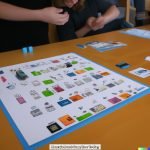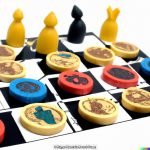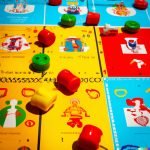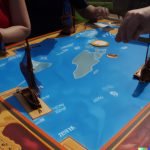Introduction
Mancala is an ancient traditional game believed to have originated in Africa sometime between the 6th and 7th centuries. Its name is derived from the Arabic word naqala, which means “to move”. The game has survived for centuries, crossing established cultural and societal boundaries through trade routes and migrations. Despite originally being played with stones or seeds on small boards carved from wood, it has since been adapted to a variety of materials ranging from pebbles to plastic chips. It continues to be immensely popular as a board game across cultures throughout the world today.
Creating a Mancala Board – Materials & Instructions
Making your own mancala set may seem like an intimidating task but with some basic supplies and careful crafting it can make for a very rewarding experience. You will need:
– 2 square pieces of plywood (ideally one foot by one foot).
– Tape measure or ruler
– Marker
– Paint brush
– Tube of acrylic paint (any color)
– Pebbles or stones
Instructions:
1. Start by laying out both pieces of plywood next to each other on a flat surface. Using your tape measure or ruler mark out small evenly spaced slots along each board lengthwise. Make sure these are wide enough to comfortably fit the pebbles you plan on using for playing pieces into them without obstructing their movement when sliding them along the board’s surface
2. Once all slots have been marked you may begin painting the boards with the acrylic paint of your choosing. Note that this is optional, however it can help provide contrast between each slot making gameplay easier during playtime 3. Start at one end slot and slowly add pebbles into each indentation as evenly as possible so that by end every slot contains equal numbers of playing pieces according to desired board size/quantity before completing construction 4. Your board is now ready for use! Place aside in a dry location until you are ready for playtime
Have on Hand
Making a Mancala game board is a great diy activity for kids of all ages. All you need is some empty egg cartons, wooden sticks, glue, and paint to make a beautiful, colorful game board.
First of all, cut the egg cartons into 12 pieces using scissors. Place the 12 pieces flat on your working surface and arrange them in two rows to resemble a checkerboard pattern. Trace around each piece with a pencil to draw its outline onto your table or the other surface of your choice.
Next, take the wooden sticks and cut two lengths into strips that are long enough (about 3-4 inches) to fit across the board and 4 lengths into thin strips that are short enough (about 1 inch) to fit between each space on the board. Glue one vertical strip onto each side of the board and one horizontal strip across each row of spaces. Wait for it to dry completely before proceeding.
Once dry, take some paints and decorate the whole thing! You can get creative here by adding different colors or patterns – whatever you’d like! When finished painting let it dry before beginning play! Finally, place four stones into each space on the board to get ready for playing mancala!
Step by Step Guide to Preparing the Wooden Board
1. Start by grabbing two 18-inch long boards of equal width. For the best mancala experience, choose a type of wood that is strong and durable such as birch or oak.
2. Sand the edges of both boards with fine-grit sandpaper to create smooth sides.
3. Place each board in front of you side by side, extending outwards from the same point that you will use as the center shape for the board’s shape.
4. Using a pencil, sketch out a half moon shape along the length of both boards which will be used to mark out where every hole in the game should be positioned on each part of the board. The total number of holes should be 24, 12 on each side of the half moon shape formed by your two boards together.
5. Using a jigsaw, cut along your sketch lines until all 24 holes have been created in both parts of the board. You should now have 2 identical half-moon shaped boards featuring 12 evenly distributed holes across them both, ready to form your game board when you join them together at their center points using screws or nails simultaneously through their connective riverts
6. Use blue construction paper and glue grids over each hole then use markers or paint pens to draw small circles inside them so they can symbolize countable stones during play time over time (or any other type token).
7 Feel free to add additional design features such as staining or painting before finally joining both parts together with glue or wood filler if needed and enjoy your homemade Mancala Board!
Carve Out the Game Pits
Making a mancala game board is an easy and fun DIY project. To start, you’ll need some wood, either in the form of plywood or branches . If you’re using pieces of wood, make sure each one is roughly the same size and width so that your game board looks uniform. Then, use a handsaw to cut out six pits for each side of the board. Make sure that each pit is about two inches wide and two inches deep . Drill four evenly spaced holes at each end of the plank; these will be used to store excess stones. You can also add decorative touches like paint or etching to give your board a personal touch.
Final Touches
Drilling a hole into each pit will give them dimension and create a more finished look. Depending on the desired aesthetic for your game board, you can have different sized holes and make them either round or rectangular. Use a drill press to carefully and accurately complete this task. It’s important to drill slowly and evenly so that the hole is the same size throughout. Make sure to measure each hole using calipers before proceeding. After all of the holes are drilled, smoothen out any jagged edges with sandpaper. Finally, use a clear-coat finish such as polyurethane to protect the tops of your pits so they last longer and stay in better condition over time. With this final step, your mancala game board is now complete!
Customize
There are many ways to customize a Mancala game board. Once the necessary components have been acquired and the game board has been constructed, turn it into an individualized artwork! First and foremost, consider staining or painting the playing surface. Using a variety of colors can add bright visual appeal, especially to something simply made out of wood. Adding additional decorations such as small wooden pieces, pieces of fabric, shells, or even marbles in each space creates an interesting texture and depth that enhances game play. To make the board more personal, add a piece of artwork that glorifies the players’ hobby or other meaningful symbols to further individualize it. Lastly, organize any accessory pieces needed for gameplay on set side trays for easy access during gameplay. With just a few simple alterations, your basic homemade Mancala game board can become something that is truly one-of-a-kind!
Learn to Play
Mancala, also known as Kalah, is a simple board game that is easy to pick up but can take a lifetime to master. Playing Mancala requires two players, each of whom need their own game board. To make your own game board you will need:
1) A flat surface on which to build the board, such as a tabletop or hard floor.
2) Two playing pieces per player—token beads or marbles work best.
3) Four items to hold the beads in place—these could be fancier stones and stones with unique patterns or plain stones like pebbles.
4) Markers to divide the playing surface into four quadrants – these could be colored tape, chalk lines or decorative stones/beads
5) A way to keep track of score—pen and paper allows for accurate scoring throughout the game.
To begin building your Mancala game board you will want to divide your playing surface into four quadrants using either lines drawn using markers or small river rocks around the edge of each quadrant (one line representing one ‘pit’). Place two rows of six pits in either side of the table so that there are 12 total pits surrounding your two players’ home pits. These smaller pits represent where players store their pieces until they reach the home pits at either end of the field—this signifies when pieces have been taken out of play.
Next, set up each player’s home pit by placing four items in them: a stone, a marble/bead stone representing both in-play pieces and scoring pieces; and some decoration item to designate this area as a player’s ‘land’. Next, each player takes alternating turns dropping their pieces into any pit they choose on their opponent’s side while attempting to capture their opponent’s pieces. Depending on how many pieces have been dropped into a particular pit before it empties out completely, the player is rewarded extra points for each piece that was removed from play during that turn; these points are then recorded down on your timer sheet for scorekeeping purposes at the end of every round.
Now that you’ve set up your Mancala game board and know how to play it’s time for some action! Each player gets 12 pieces at the beginning stages outside of home pits; these must be moved one by one between 12 open holding spots until they become empty and all existing points are deposited into each respective players home pits. The winner is determined by who has collected more points than his/her opponent after every move has been completed!
Wrap Up
Making a Mancala game board can be an enjoyable and rewarding project. It is the perfect way to get creative and make something beautiful that you can use for years to come! There are many benefits that come with learning how to construct a Mancala game board. Not only will you learn a valuable craft or skill, but you will also be able to customize your own unique style of game board, making Mancala games even more meaningful and special for whoever plays it! Moreover, constructing a Mancala game board provides an opportunity for entertainment and family fun, giving everyone the chance to learn skills such as strategy and critical thinking – essential life lessons that can be applied in other areas besides just playing the actual game itself. In addition, as you continue to play more frequently over time with others using your own game board, deep connections are built as each person shares in their love and appreciation of the classic Mancala game!
Credits and Sources
Making a Mancala game board is easy and fun. First, you’ll need to gather materials like Smooth River Stones, A Chess or Checkers Board, A Bowl for Each Player, Two Smaller Bowls for Storing Captured Stones. You can find all of these items at your local craft store or online.
To begin constructing the game board, place the two small bowls in the corners of the chess or checkers board. When assembling your mancala board layout, get creative with what materials you use for each hollow – from decorative stones to buttons – as long as they fit around the pre-cut board holes, it truly is a work of art!
Next up: Place four river stones in each of the 12 hollows on the game board. This is an important part of creating a unique look to your mancala gameboard! To make it easier to keep track of stones and score points more accurately throughout playtime, we recommend using contrasting colors like white and black stones or even blue and green ones. Shake up the colors when playing to add a fun flair each time!
Finally, it’s time to make sure everyone understands how to use the colors properly during their turn; this part is key in enjoying a fast-paced round of Mancala! Each player has seven sunken cups (known as “holes”) that will hold their stones. Players take turns picking up their set of stones from any one hole, moving counterclockwise by sowing one stone at a time into each successive hole until all stones have been dropped off.
Now that you have an understanding on how to create your own Mancala board game from scratch following these steps – let’s put them into practice! Have fun getting creative with what style patterned pieces you choose for your design and make sure there are enough river rocks for playing in abundance so nobody runs out during gameplay! Finally, once everything’s assembled and ready-to-go remember those rules: Whoever empties their side first wins!

I love playing all kinds of games – from classics like Monopoly to modern favourites like Ticket to Ride.
I created this blog as a way to share my love of board games with others, and provide information on the latest releases and news in the industry.





